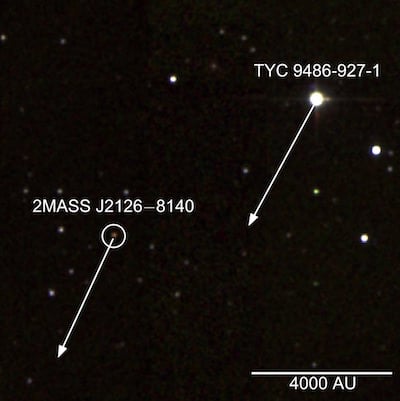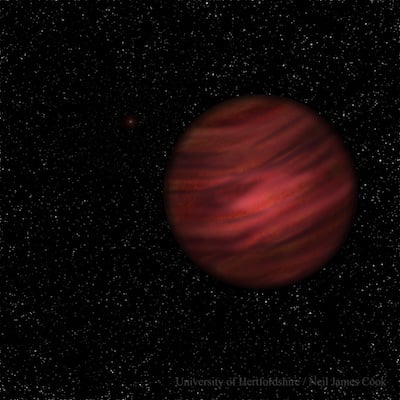The Royal Astronomical Society (RSA) has
announced the discovery
of a planet that orbits its star at a distance of 1 trillion kilometres. This is easily the furthest distance between a star and a planet ever found. For comparison, that's 7,000 times further than the Earth is from the Sun. At that distance, a single orbit takes about 900,000 years, meaning that the planet has orbited its star less than 50 times.
The planet itself was discovered in an infrared sky survey by US researchers, and following astronomical protocol it was given the charming name 2MASS J2126.
The line between planet and star isn't always clearly delineated. Gas giants like Jupiter are considered "failed stars" that didn't gather enough hydrogen and helium to begin fusion. There's only so much gas to go around, and in our Solar System, the Sun beat Jupiter to it.
Brown Dwarfs
are bodies larger than Jupiter, that came really close to fusion, but failed. They cool and fade over time, and it took additional study to determine that 2MASS J2126 was a planet, and not a Brown Dwarf. In 2014, Canadian researchers confirmed it as a free-floating planet.
[caption id="attachment_127069" align="alignnone" width="400"]
An artist's impression of the distant planet 2MASS J2126. Credit: University of Hertfordshire / Neil Cook.[/caption]
A planet drifting through space by itself may not be a rare thing. 2MASS J2126 joined a list of other starless planets discovered in the last few years. The existence of 2MASS J2126 out by itself in space didn't merit much attention. Only when a relationship was established between 2MASS J2126, and the star TYC 9486-927-1, did things get interesting.
Dr. Niall Deacon, of the University of Hertfordshire, is the lead author of the study. He has spent the last few years looking for young stars that have companions in wide orbits. Deacon and his team pored over lists of brown dwarfs, young stars, and free-floating planets, looking for relationships between them. Eventually they found that the planet 2MASS J2126 and the star TYC 9486-927-1 are both about 104 light years from our Sun, and are moving through space together. "This is the widest planet system found so far and both the members of it have been known for eight years, but nobody had made the link between the objects before," said Dr. Deacon.
The distance between the two is indeed a surprise, and a signal that we may have to change our thinking around solar system formation. We have a nice tidy theoretical model of
solar system formation
that's shaped by what we see in our Solar System. Over billions of years matter clumps together, which strengthens gravity, which draws in more matter. Eventually, if enough gas is drawn together, a star begins nuclear fusion. An accretion disk forms around the proto-star, clumps form in that disk, and planets are formed.
It's too soon to say if or how this new planet-star pair will change our understanding of solar system evolutions, or if there are other planets yet to be discovered that are orbiting TYC 9486-927-1. According to Simon Murphy of the Australian National University, co-author of the study, "... how such a wide planetary system forms and survives remains an open question."
 Universe Today
Universe Today

